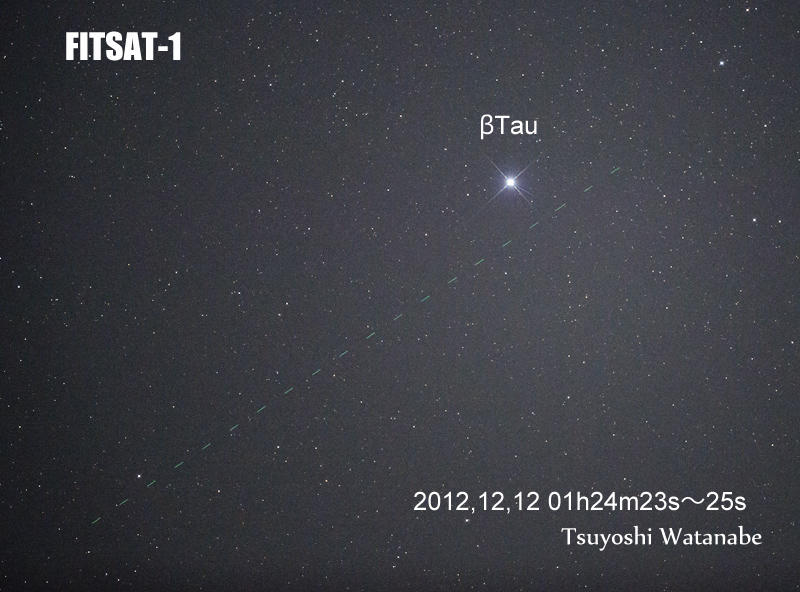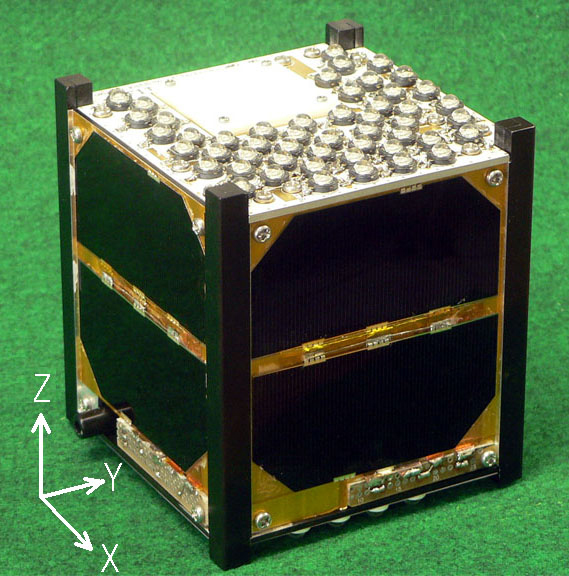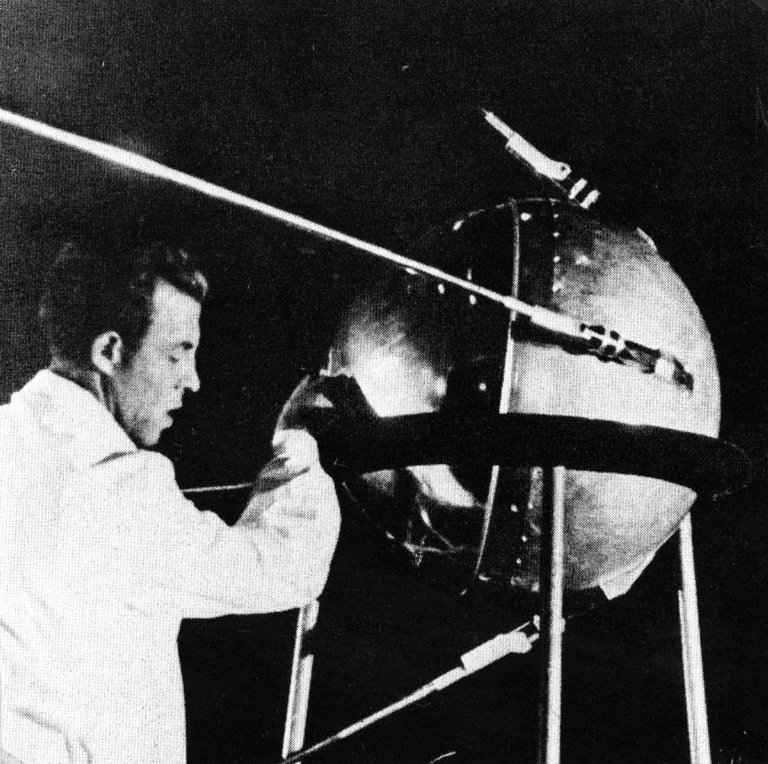
Tiny Japanese Satellite Beams Morse Code Messages from Space

An ultra-small Japanese satellite is being spotted from the ground, thanks to a set of lights that flash brightly in Morse code.
The novel cubesat, known as FITSAT-1, has been orbiting Earth since early October of last year. Though it tips the scales at less than 3 pounds (1.3 kilograms), FITSAT-1's powerful light-emitting diodes (LEDs) make it a compelling target for skywatchers.
"As long as the LEDs are active, then you will be able to see it using binoculars," veteran Canadian satellite watcher Kevin Fetter told SPACE.com
An artificial star
FITSAT-1 was built at Japan’s Fukuoka Institute of Technology. The tiny spacecraft is also called Niwaka, after "Hakata Niwaka," an improvised performance of traditional Japanese comedies with masks.
The spacecraft was carried up to the International Space Station on Japan's unmanned H-2 Transfer Vehicle-3 in July 2012, then deployed from the orbiting lab in October by Japanese astronaut Aki Hoshide. [Photos: Tiny Satellites Launch from Space Station]
To cast FITSAT-1 and two other cubesats off into space, Hoshide used the Small Satellite Orbital Deployer that was attached to the Japanese Kibo module’s robotic arm.
Get the Space.com Newsletter
Breaking space news, the latest updates on rocket launches, skywatching events and more!
FITSAT-1’s orbit is taking it between 51.6 degrees south latitude and 51.6 degrees north latitude. The cubesat contains a neodymium magnet that forces it to point always to magnetic north, like a compass.

Working well
A successful test of FITSAT-1's LED optical beacon took place over Japan on December 11.
"All functions of FITSAT-1 are sound and work very well," said Takushi Tanaka, leader of the project at the Fukuoka Institute of Technology.
Images of the blinking FITSAT-1 have been taken in Japan, Germany and the United States, Tanaka told SPACE.com. The tiny spacecraft has succeeded in its primary goal of investigating optical communication techniques for satellites, he said.
For Niwaka to be visible, the night sky must be dark enough that a ground observer can see the Milky Way, Tanaka has said. Also, many people are unaware that they have succeeded in photographing the fleeting, flashing light until they've magnified and closely inspected their images.
The FITSAT-1 team attempts to accommodate skywatchers who want to catch a glimpse of the little satellite.
"As observing the light is not so easy, we will flash the light on requests. If you have a plan for observing the light, please advise me [of] the time and date with your latitude and longitude," Tanaka wrote on the FITSAT-1 website. "Now we have a plan for flashing at 09:25:00 on 9th Feb. for the west coast of USA."

Tanaka is no aerospace specialist. He's a professor of computer science and engineering, with research interests that specialize in artificial intelligence, language processing, logic programming and robot soccer, in addition to cubesats.
The backgrounds of Tanaka and his team make Niwaka pretty special, the researcher said
"Most cubesats are developed by some kind of space department of a university, while FITSAT-1 is developed by amateurs of space." Tanaka said.
"Though I do not have much knowledge about space," he added, "I am a ham radio [devotee] since the age of the vacuum tube."
Editor's Note: If you capture a great photo of Japan's FITSAT-1 in the night sky, or any other stargazing sight, and want to share it with SPACE.com, send the images, comments and your name and viewing location to managing editor Tariq Malik at: spacephotos@space.com.
Leonard David has been reporting on the space industry for more than five decades. He is former director of research for the National Commission on Space and a past editor-in-chief of the National Space Society's Ad Astra and Space World magazines. He has written for SPACE.com since 1999. Follow SPACE.com on Twitter @Spacedotcom. We're also on Facebook & Google+.
Join our Space Forums to keep talking space on the latest missions, night sky and more! And if you have a news tip, correction or comment, let us know at: community@space.com.

Leonard David is an award-winning space journalist who has been reporting on space activities for more than 50 years. Currently writing as Space.com's Space Insider Columnist among his other projects, Leonard has authored numerous books on space exploration, Mars missions and more, with his latest being "Moon Rush: The New Space Race" published in 2019 by National Geographic. He also wrote "Mars: Our Future on the Red Planet" released in 2016 by National Geographic. Leonard has served as a correspondent for SpaceNews, Scientific American and Aerospace America for the AIAA. He has received many awards, including the first Ordway Award for Sustained Excellence in Spaceflight History in 2015 at the AAS Wernher von Braun Memorial Symposium. You can find out Leonard's latest project at his website and on Twitter.









